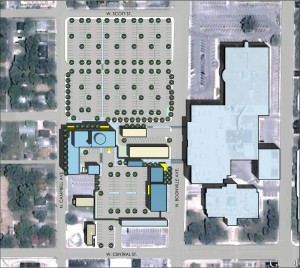Contributor: David Crabtree
Public Safety Building Survivable Design: Part 2: Essential Facility
There are a multitude of standards that stipulate building envelope requirements, building structural loads, and envelope survivability for Public Safety Buildings. These codes and Standards Include: FEMA 361, ICC 500, IBC, NFPA 1221, ASTM E1996/E1886, and ASCE 7. It should be noted the authority having jurisdiction must be identified as they will determine local codes and the application. The first item to note is this building type is considered an “Essential Facility” per IBC and FBC and this will have inherent increases in the base code requirements, but these are quickly surpassed by FEMA 361 or Alternate Review Methods per ASCE 7. These codes are not unilaterally applied, and they may have overlapping and sometimes conflicting requirements. So, it is important to determine early on with the client and authority having jurisdiction which codes will apply. Some are elective codes due to Grant Application or client requirements and others are mandated as the adopted local or regional code. For example, the Florida Building Code (FBC) can be very restrictive when trying to also meet other survivable codes due to the stringent nature of the FBC and Florida Product Approval; whereas, other states mostly refer to IBC as the primary code and there is more flexibility which allows the Engineer of record to sign off on the system and its ability to meet testing requirements for the authority having jurisdictions approval. In general, regardless of the code specifics, the building support structure and enclosure may need to incorporate protective materials and system design, including, but not limited to the following: progressive collapse protection if FEMA 361 is required, hardened wall construction, specialized glazing systems, protective intake ventilation, and other measures deemed necessary based on the level of threat determined. Blast Requirements, Impact Protection, wind speed determination, lateral load bracing, seismic loads, snow loads, rain loads, and other envelope design systems will be further guided by the outlined codes.
In order to meet the stringent design requirements, specialized systems are specified for the public safety building typology. Exterior walls are ideally constructed of concrete materials or other survivable systems and openings are protected from impact; however, there is a wide range of survivability requirements per code, regional requirements, local hazards, and client requests that complicate this issue. Lower wind speeds and impact per Essential Facility regional codes such as FBC or IBC may allow for CMU block or other architectural cladding systems without issue as they may only need to meet a 90mph wind speed and minimal impact of 9# 2×4 @ 34 mph if any at all; however, as the survivability needs increase the systems become more limited and stringent. In the case of FEMA 361, the wind speeds may be 200-250 mph with an impact of 15# 2×4 @ 100 mph which would require 8” cast in place concrete walls which can be either load bearing or over a steel or concrete frame, concrete roof decks and opening protection systems for all windows, louvers, and other building envelope penetrations. These two extremes have a clear budget and system availability implications that must be considered early in the process.
Redundant Design Standards
Due to the nature of this building type and the need to maintain operations during natural and manmade events there are many attributes that are unique and beyond the typical office building that will be determined by codes such as FEMA 361 and NFPA 1221. This includes strengthened building envelope design standards noted above, increased structural requirements, and the ability to maintain continued service from all building utilities noted below. All of these items below should be reviewed and vetted with all design consultants and client team members to ensure the project needs are being accommodated as anticipated.
- Provide utility systems backup in the event of prolonged power, water, data, and sewage outages.
- Provide 72 hours generator back up and assume some load shedding is possible. 24 hour back up is a minimum if Communication PSAP’s are in the program and NFPA 1221 will dictate. In some cases FEMA 361 only requires 2 hours of back up for Tornado prone areas whereas 24 hour back up is required for Hurricanes due to the prolonged threat. It is important to review this issue with the client, any grant criteria required, code requirements, consultants, and authority having jurisdiction.
- Automatic transfer switches should be required.
- Provide the ability to bring in a flat bed truck to plug another generator should one go down during an event.
- Fuel tank sizes will be estimated based on 72 hours of back up unless determined otherwise.
- Per civil design estimates, the team should determine gallon/day of sewage storage for anticipated building loads during activation. These occupancy levels should be reviewed with the client group.
- There are multiple ways to deal with redundant sewage storage such as the design of a lift station with an oversized well to hold sewage in the event power or the line out is broken and may also have generator back up.
- If no lift station is required, then a sewage storage tank can be utilized and may need to be aerated per local codes which would need to be determined by your appropriate engineers.
- Existing gravity line capacity can also be considered if the current infrastructure is new, sized large enough to hold 72 hours of capacity, and well protected without risk of deep tree roots or other hazards that would interrupt flow during activation.
- Fresh water storage via tanks should be designed to serve the number of occupants assumed during activation per the projects Plumbing Engineers review and client feedback. These tanks would have circulation pumps tied back to the generator. Other options include:
- Large bladders storage, large bottled water storage, and/or options for small tanker trucks with water tanks to connect to the main building via Siamese connection. If the anticipated pumper trucks are not pressurized to a level that can serve the building pumps will need to be designed.
- The Communications PSAP programs and associated equipment rooms should be designed with redundant HVAC systems and UPS back up in mind to cover momentary power loss during transfer.
- Redundant Feeds for Data from two distinct service points is ideal and consideration for onsite communication tower or roof mounted antenna would certainly be essential if the program includes a PSAP.
- All generators and HVAC equipment, pumps, etc at the exterior central energy plant should be protected from impact.
Redundant building systems such as Potable Water, Sanitary Sewer, HVAC, Power, Data and Communications systems are very complex issues that must be reviewed with all stakeholders to ensure the project is meeting the anticipated codes, grant criteria, program, and client expectations.




